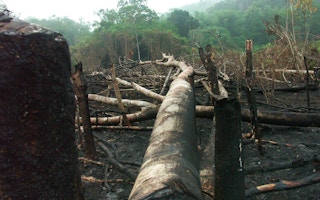Marking forests as protected by the government is a good way to stop deforestation and safeguard biodiversity but this may not be enough for conservation in Indonesia.
Instead, prevention and monitoring of road construction within protected areas, the creation of new logging concessions or the further implementation of forest plantations could be more effective.
Stronger enforcement of the protected areas and alternative livelihoods to small-scale farmers could also go a long way in conserving forests than reliance on protected areas alone, according to a new study by scientists at the National University of Singapore (NUS) first published in online in the journal Global Environmental Change on 13 March 2015.
“Extensive deforestation in Indonesia is a cause for global concern as it contributes substantially to land-based global carbon emissions and potentially high rates of biodiversity loss,” said Assistant Prof Roman Carrasco of the Department of Biological Sciences at the NUS Faculty of Science, who led the research study with Assistant Professor Alex Cook of the NUS Saw Swee Hock School of Public Health.
Analysis of deforestation and protected area effectiveness in Indonesia has been hampered by the lack of any nation-wide data, NUS said, and the study’s nation-wide analysis is useful in understanding the factors affecting the rate of deforestation and the measures needed to tackle it.
Global rates of tropical deforestation have increased over the last two decades, particularly in Southeast Asia, which lost about 32 million hectares of forests between 1990 and 2010.
Indonesia accounted for about 61 per cent of forest loss in Southeast Asia during that time, NUS said.
Distribution of deforestation
The study analysed deforestation patterns as well as the effectiveness of protected areas in the five main islands of Indonesia – Sumatra, Java, Kalimantan, Sulawesi and Papua – by using remote sensing maps of land-use change from 2000 to 2010.
The team then constructed spatial Bayesian models - studies of probabilities using statistics - and used the International Union for Conservation of Nature (IUCN) classification of protected areas in order to evaluate the influence of potential factors on deforestation.
They also projected future deforestation using those models.
They discovered that deforestation between 2010 and 2020 is likely to occur close to the areas that have been deforested before 2010. It identified the south and west part of Kalimantan, the north-west Sumatra and West Papua as areas that will be subject to the greatest rates of deforestation.
They also found out that protected areas that were strictly set aside to protect biodiversity and where human visitation was rigorously controlled were shown to be ineffective at slowing down deforestation while the other categories of protected areas achieved mixed results.
“In addition, deforestation was found to be lower as the transport cost to the market increases, and for higher elevation. At the same time, high agricultural rent led to higher deforestation,” NUS said.
They also found out the deforestation was higher in areas outside concession zones, as concessions are managed by multinationals that have the resources to keep illegal loggers away.
These multinationals are under strong scrutiny from the global community and many of them have pledged zero deforestation policies, they added.
“Once they deforest the land they need, they set aside forest areas and are effective at protecting it. On the other hand, land outside concessions is managed by the government and poorly enforced against illegal logging,” Carrasco said.
However. mounting demands for timber and agricultural products along with weak enforcement are changing this situation, resulting in illegal logging and agricultural encroachment within Indonesia’s protected areas,” said Cook. The team hopes that their research will play in part in helping the country formulate better conservation policies.
The research was conducted by Cyrille Brun, a Masters student at the NUS Faculty of Science under the supervision of Cook and Carrasco.

















